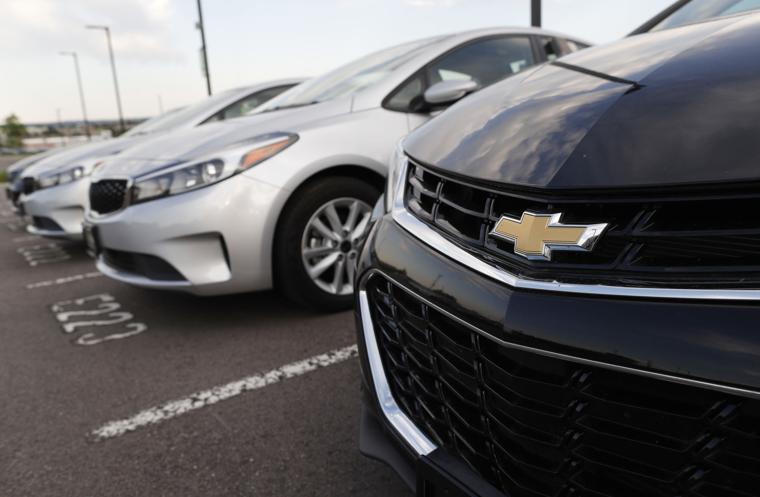For the past five years, few people wanted a lowly used small car such as the Chevrolet Cruze or Ford Focus.
Compact and subcompact cars sat on dealer lots for weeks as the SUV craze in the U.S. accelerated.
Early this year, dealers and industry analysts started to see a change, with sales and prices for used compact and subcompact cars increasing after taking a fall every year since 2013. That’s in part because of rising gas prices, stagnant middle class wages and deals that are still too good to pass up.
Until recently, lower demand had depressed car prices, but especially for smaller ones, which bottomed out in 2017 as the cost of their closest competitor for basic transportation — small SUVs — was rising. By early this year, analysts and dealers say the spread between small SUVs and cars was so large that the cars became more attractive. Also, rising gasoline prices sent buyers on a tight budget from SUVs and other segments to the lower-cost small cars.
At Paddock Chevrolet in Kenmore, New York, near Buffalo, the dealership was paying $10,200 to $10,500 for 3-year-old Cruzes at the beginning of the year. Now it’s paying $11,500, said owner Duane Paddock. “We did find it surprising,” he said. “Normally prices continued to come down. It’s definitely been harder to find the lower-value vehicles.”
In the first quarter of 2013, the average three-year-old compact car sold for $14,328, according to the Edmunds.com auto pricing site. By the same period in 2017, the sales price had fallen almost 10 percent to $12,958. But in the first quarter of this year it rose to $13,464. (Edmunds regularly provides content, including automotive tips and reviews, for distribution by The Associated Press.)
Black Book, a car pricing and automotive analytics company, reports that sales of used compact and subcompact cars each are up 5 percent in the first quarter from a year earlier.
“Compact cars have been beaten down in value,” said Anil Goyal, executive vice president of Black Book, “They’re very attractive for a value buyer.”
Five years ago, the cars were about 50 percent of U.S. new-car sales. But trucks and SUVs have since risen to 67 percent.
Ivan Drury, senior analyst at Edmunds, believes gas prices are a big part of the equation. By the end of March, the national average price per gallon of regular rose to $2.61, 33 cents higher than the same time last year. It continued to jump during the second half, with prices now hovering around $2.85, 58 cents more than a year ago, according to AAA. Last week the OPEC cartel countries agreed to pump more crude, a move that should contain recent price increases.
Used-car buyers typically are more sensitive to prices, especially if gasoline is taking a bigger bite out of their budgets, and that’s fueling increased demand for smaller cars, Drury said.
The average wholesale value (what dealers pay at used-vehicle auctions) of a 3-year-old compact car is about $9,800, according to Goyal. But the average compact crossover SUV is $13,250. “There’s a substantial difference here,” he said.
So far, there hasn’t been a similar shift in sales of new small cars or new or used midsize cars as the truck and SUV boom continues, Drury said. He doesn’t see the new-vehicle market changing even with gas hitting $3 per gallon in much of the nation. But used midsize cars could see increased prices and demand when second-quarter data comes out, he said.
Glenn Mears, owner of five dealerships around Canton, Ohio, including Honda, Nissan, Ford and Fiat Chrysler, says they’re having trouble finding compact used cars, but not midsize ones. “You can find (midsize Honda) Accords all day long,” he said. “You can’t find (compact) Civics right now.”
Drury sees gradual increases in small-used-car prices continuing, but nothing dramatic unless gasoline hits $4 per gallon. He bases his prediction on consumer behavior during previous gas price spikes.
Stagnant wages also may be a factor. Hourly pay is growing more slowly than it has in the past when the unemployment rate was this low, around 4 percent. But now, rising inflation has eroded some of the benefit. In May, average hourly wages rose 2.7 percent from a year earlier, but inflation increased by slightly more at 2.8 percent.
“All of those combined together might tell a fair amount of the story,” said Mears.
(AP)












One Response
Compact and small cars are not so practical for this stage in my life with children. However, during my next purchase I’l plan on having one “family car” and one compact to just get me to work and back Mon-Fri. Will definitely save on gas mileage.